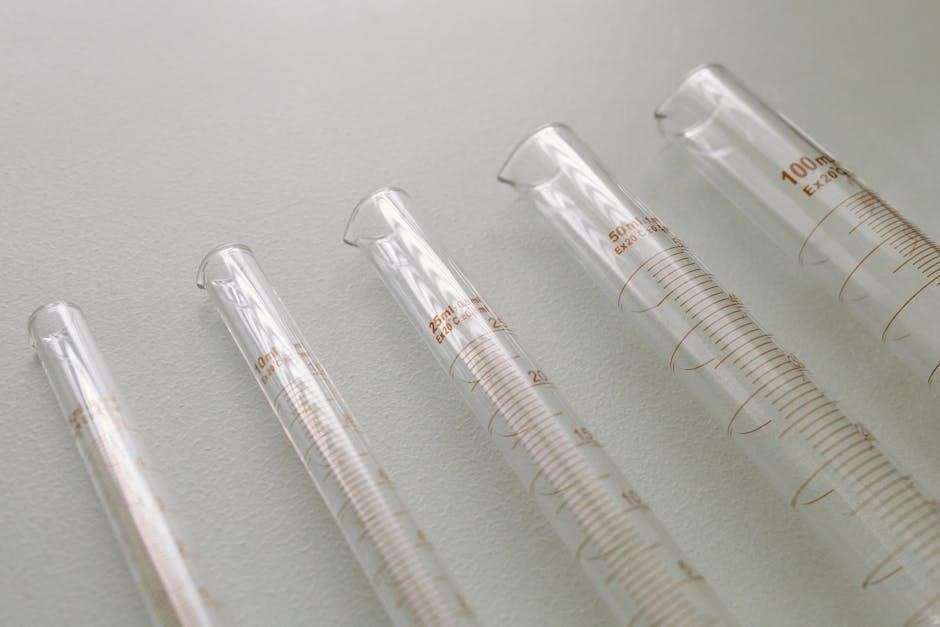and practice worksheets available online for students to learn and understand the concept easily always․
Overview of the Topic
The topic of volume of prisms and cylinders worksheet answers pdf is a mathematical concept that deals with calculating the volume of different types of prisms and cylinders․ This topic is typically taught in middle school and high school mathematics classes․ The concept of volume is used to measure the amount of space inside a three-dimensional object․ Students are expected to learn how to calculate the volume of various prisms and cylinders using formulas and step-by-step lessons․ The internet provides a wide range of resources, including practice worksheets and answer keys, to help students learn and understand this concept․ With the help of these resources, students can practice calculating volumes and check their answers to ensure they are correct․ The topic of volume of prisms and cylinders is an important part of mathematics education, as it helps students develop problem-solving skills and understand the relationship between different mathematical concepts․

Formulas for Calculating Volume
Formulas for volume of prisms and cylinders include length, width, and height, using specific equations to calculate volume accurately always online․
Volume of Rectangular Prisms
The volume of rectangular prisms can be calculated using the formula length times width times height, which is often represented as V = lwh, where V is the volume, l is the length, w is the width, and h is the height․ This formula is used to find the volume of a variety of rectangular prisms, including cubes, which are special types of rectangular prisms where all sides are equal․ To calculate the volume of a rectangular prism, simply multiply the length, width, and height together, using the units of measurement for each dimension, such as inches, feet, or meters․ For example, if a rectangular prism has a length of 6 inches, a width of 4 inches, and a height of 2 inches, the volume would be calculated as V = 6 * 4 * 2 = 48 cubic inches․ Using this formula, students can practice calculating the volume of different rectangular prisms, including those with varying dimensions and units of measurement, to develop their understanding of this important concept in geometry and measurement․ The calculation of volume is a fundamental skill in mathematics and science․
Volume of Cylinders
The volume of cylinders is calculated using the formula V = πr^2h, where V is the volume, π is a constant approximately equal to 3․14, r is the radius of the cylinder, and h is the height of the cylinder․ This formula is used to find the volume of a variety of cylinders, including those with different radii and heights․ To calculate the volume of a cylinder, simply plug in the values for the radius and height into the formula, using the units of measurement for each dimension, such as inches, feet, or meters․ For example, if a cylinder has a radius of 3 inches and a height of 5 inches, the volume would be calculated as V = π * 3^2 * 5 = approximately 141․37 cubic inches․ Using this formula, students can practice calculating the volume of different cylinders, including those with varying dimensions and units of measurement, to develop their understanding of this important concept in geometry and measurement, and apply it to real-world problems and applications, with the help of worksheets and online resources․ The calculation of volume is a fundamental skill in mathematics and science, and is used in a wide range of fields․

Types of Problems
Types include word problems, multiple-choice questions, and
- fill-in-the-blank
exercises to assess understanding of volume calculations always and accurately online․
Word Problems
Word problems are an essential part of the volume of prisms and cylinders worksheet, allowing students to apply their knowledge to real-world scenarios․ These problems typically involve finding the volume of a prism or cylinder given its dimensions, and may include additional information such as the material it is made of or its intended use․ For example, a word problem might ask students to find the volume of a rectangular prism with a length of 8 km, a width of 7 km, and a height of 1407․4 km․ By working through these types of problems, students can develop their critical thinking skills and learn to approach complex problems in a logical and methodical way․ The use of word problems also helps to make the material more engaging and relevant to students’ lives, as they can see the practical applications of the concepts they are learning․ With practice, students can become proficient in solving word problems and applying their knowledge of volume calculations to a wide range of situations․
Multiple-Choice Questions
Multiple-choice questions are a key component of the volume of prisms and cylinders worksheet, providing students with a quick and efficient way to assess their understanding of the material․ These questions typically involve selecting the correct answer from a list of options, and may include visual aids such as diagrams or illustrations to help students understand the problem․ The questions may ask students to find the volume of a prism or cylinder, or to identify the correct formula for calculating volume․ By using multiple-choice questions, students can test their knowledge and identify areas where they need to focus their studies․ The questions can also be used to reinforce key concepts and help students develop their problem-solving skills․ With a range of question types and difficulty levels, multiple-choice questions can be an effective way to engage students and help them learn about volume calculations․ Online resources provide access to a wide range of multiple-choice questions․

Worksheets and Resources
Worksheets and resources are available online, including pdf files, to support learning about volume calculations with ease always․
Practice Worksheet
A practice worksheet is a valuable resource for students to hone their skills in calculating the volume of prisms and cylinders․ The worksheet typically includes a series of problems, each presenting a different scenario, such as finding the volume of a rectangular prism or a cylinder․ Students can use the formulas and techniques learned in class to solve these problems, and then check their answers against the provided solutions․ The practice worksheet may also include visual aids, such as diagrams or graphs, to help students understand the concepts and apply them to real-world situations․ By working through the practice worksheet, students can build their confidence and fluency in calculating volumes, and develop a deeper understanding of the underlying mathematical principles․ The practice worksheet is often available in pdf format, making it easy to access and print out for use in the classroom or at home․
Answer Key
The answer key is a crucial component of the volume of prisms and cylinders worksheet, providing students with the correct solutions to the problems․ The answer key is typically found at the end of the worksheet or in a separate document, and is often available in pdf format for easy access․ By referring to the answer key, students can check their work and identify areas where they need improvement․ The answer key may include step-by-step solutions, formulas, and explanations to help students understand the concepts and techniques used to calculate volumes․ Teachers can also use the answer key to quickly grade assignments and provide feedback to students․ Additionally, the answer key can be used as a study guide or reference tool for students to review and prepare for tests and exams, helping them to master the skills and concepts needed to succeed in mathematics․ The answer key is an essential resource for students and teachers alike․

Importance of the Topic
Understanding volume of prisms and cylinders is crucial for real-world applications and problem-solving skills always in mathematics and engineering fields effectively․
Real-World Applications
The concept of volume of prisms and cylinders has numerous real-world applications in various fields, including architecture, engineering, and design․ For instance, architects use volume calculations to determine the amount of materials needed for construction projects, such as building foundations, walls, and roofs․ Engineers also apply volume formulas to design and optimize systems, like pipelines, tanks, and containers․ Additionally, volume calculations are essential in fields like chemistry and physics, where scientists need to measure and calculate the volumes of substances and objects․ Furthermore, volume of prisms and cylinders is used in everyday life, such as calculating the volume of water in a swimming pool or the volume of a room for heating and cooling purposes․ By understanding and applying volume concepts, individuals can develop problem-solving skills and make informed decisions in their personal and professional lives, using online resources like worksheets and practice problems to reinforce their knowledge․